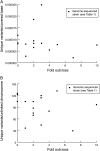Analysis of multiple ethyl methanesulfonate-mutagenized Caenorhabditis elegans strains by whole-genome sequencing
- PMID: 20439776
- PMCID: PMC2881126
- DOI: 10.1534/genetics.110.116319
Analysis of multiple ethyl methanesulfonate-mutagenized Caenorhabditis elegans strains by whole-genome sequencing
Abstract
Whole-genome sequencing (WGS) of organisms displaying a specific mutant phenotype is a powerful approach to identify the genetic determinants of a plethora of biological processes. We have previously validated the feasibility of this approach by identifying a point-mutated locus responsible for a specific phenotype, observed in an ethyl methanesulfonate (EMS)-mutagenized Caenorhabditis elegans strain. Here we describe the genome-wide mutational profile of 17 EMS-mutagenized genomes as assessed with a bioinformatic pipeline, called MAQGene. Surprisingly, we find that while outcrossing mutagenized strains does reduce the total number of mutations, a striking mutational load is still observed even in outcrossed strains. Such genetic complexity has to be taken into account when establishing a causative relationship between genotype and phenotype. Even though unintentional, the 17 sequenced strains described here provide a resource of allelic variants in almost 1000 genes, including 62 premature stop codons, which represent candidate knockout alleles that will be of further use for the C. elegans community to study gene function.
Figures




Similar articles
-
C. elegans mutant identification with a one-step whole-genome-sequencing and SNP mapping strategy.PLoS One. 2010 Nov 8;5(11):e15435. doi: 10.1371/journal.pone.0015435. PLoS One. 2010. PMID: 21079745 Free PMC article.
-
Whole-genome profiling of mutagenesis in Caenorhabditis elegans.Genetics. 2010 Jun;185(2):431-41. doi: 10.1534/genetics.110.116616. Epub 2010 May 3. Genetics. 2010. PMID: 20439774 Free PMC article.
-
A machine learning enhanced EMS mutagenesis probability map for efficient identification of causal mutations in Caenorhabditis elegans.PLoS Genet. 2024 Aug 26;20(8):e1011377. doi: 10.1371/journal.pgen.1011377. eCollection 2024 Aug. PLoS Genet. 2024. PMID: 39186782 Free PMC article.
-
Counting mutagenized genomes and optimizing genetic screens in Caenorhabditis elegans.PLoS One. 2007 Nov 7;2(11):e1117. doi: 10.1371/journal.pone.0001117. PLoS One. 2007. PMID: 17989770 Free PMC article. Review.
-
Next-Generation Sequencing-Based Approaches for Mutation Mapping and Identification in Caenorhabditis elegans.Genetics. 2016 Oct;204(2):451-474. doi: 10.1534/genetics.115.186197. Genetics. 2016. PMID: 27729495 Free PMC article. Review.
Cited by
-
Systematic prediction of EMS-induced mutations in a sorghum mutant population.Plant Direct. 2022 May 25;6(5):e404. doi: 10.1002/pld3.404. eCollection 2022 May. Plant Direct. 2022. PMID: 35647479 Free PMC article.
-
Deep sequencing strategies for mapping and identifying mutations from genetic screens.Worm. 2013 Jul 1;2(3):e25081. doi: 10.4161/worm.25081. Epub 2013 May 21. Worm. 2013. PMID: 24778934 Free PMC article. Review.
-
Maintenance of neuronal laterality in Caenorhabditis elegans through MYST histone acetyltransferase complex components LSY-12, LSY-13 and LIN-49.Genetics. 2010 Dec;186(4):1497-502. doi: 10.1534/genetics.110.123661. Epub 2010 Oct 5. Genetics. 2010. PMID: 20923973 Free PMC article.
-
Phenomic and Genomic Characterization of a Mutant Platform in Cucurbita pepo.Front Plant Sci. 2018 Aug 3;9:1049. doi: 10.3389/fpls.2018.01049. eCollection 2018. Front Plant Sci. 2018. PMID: 30123227 Free PMC article.
-
C. elegans mutant identification with a one-step whole-genome-sequencing and SNP mapping strategy.PLoS One. 2010 Nov 8;5(11):e15435. doi: 10.1371/journal.pone.0015435. PLoS One. 2010. PMID: 21079745 Free PMC article.
References
-
- Anderson, P., 1995. Mutagenesis, pp. 31–58 in Caenorhabditis elegans—Modern Biological Analysis of an Organism, edited by H. F. Epstein and D. Shakes. Academic Press, New York/London/San Diego.
Publication types
MeSH terms
Substances
Grants and funding
LinkOut - more resources
Full Text Sources

